Chamomile Tea & Honey Shampoo Bar Recipe
This herbal shampoo bar recipe combines the simple goodness of chamomile tea with nourishing honey to create a wonderful lathering experience for your hair.
(Directions are included for both hot process and cold process soap methods.)
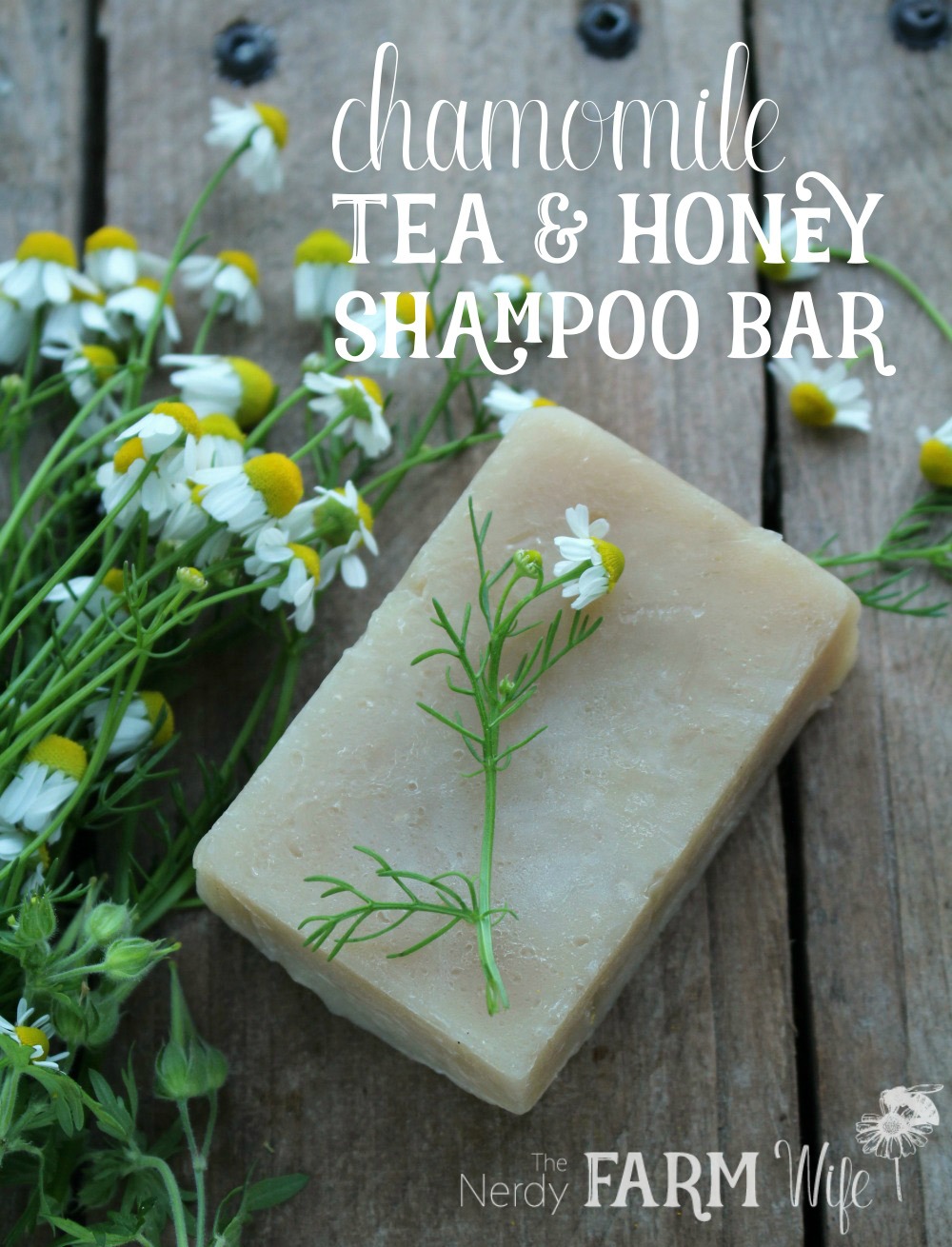
Fresh chamomile from my garden, along with a jar of honey from our beehives inspired this herbal shampoo bar recipe.
Chamomile is a soothing herb that’s great for all hair types, while nourishing honey adds an extra boost to lather.
Ingredients Needed
Measurements of oils, lye and distilled water/tea are by weight. An accurate scale is required make soap.
- 10 oz (283 g) olive oil
- 8 oz (227 g) coconut oil
- 4 oz (113 g) castor oil
- 2 oz (57 g) avocado oil
- 2 oz (57 g) shea butter
- 2 oz (57 g) sweet almond oil
- 10 oz (283 g) cooled chamomile tea (*See NOTE For Cold Process amount)
- 3.93 oz (111 g) lye (sodium hydroxide)
- 1 tbsp (15 ml) honey mixed with 1 tbsp (15 ml) distilled water
*NOTE: Use the full amount of chamomile tea (10 oz/283 g) for hot process (crock pot) soap. If making cold process, you can reduce the amount of tea to 8 oz (227 g) so that the soap ends up firmer and releases from the mold a lot faster. Reducing the water also shortens the amount of time needed to reach trace.
Yield: 7 to 9 bars, depending on mold size and type (28 oz oils + 10 oz water + almost 4 oz lye = 42 oz = 2 lbs, 10 oz)
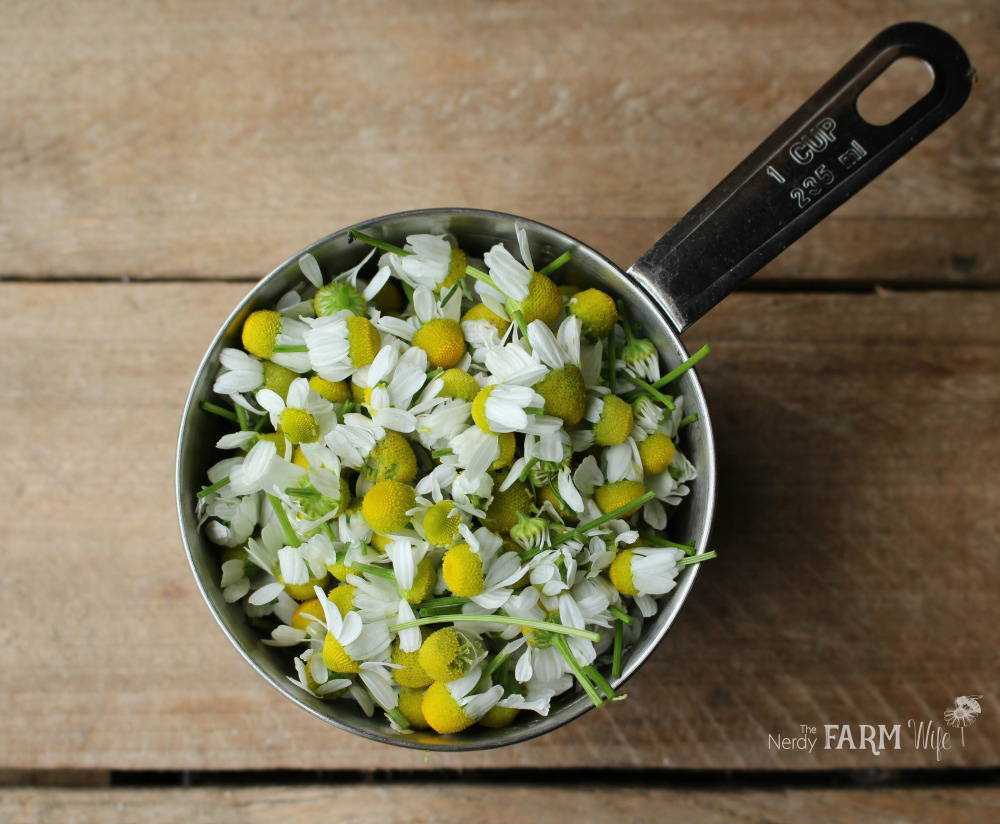
To Make the Chamomile Tea
Boil 10 oz (283 g) of distilled water and pour over 1 cup fresh chamomile flowers. If you don’t have fresh chamomile flowers, you can use 1/2 cup dried flowers instead.
You could also use chamomile tea bags from the grocery store.
Allow the flowers to steep for 30 minutes to an hour before straining. Herbal tea should be room temperature or colder before using in a soap recipe. Never use warm or hot tea, or your lye may overheat.
Before You Begin
If you’ve never made soap before, be sure you’re completely familiar with the process before proceeding. (Check out my Soap Making 101 post for more in-depth details.)
You may also find my Handmade Natural Soaps eBook Collection helpful – it includes:
- Handmade Natural Soaps eBook
- All Natural Milk Soaps eBook
- DIY Specialty Soaps eBook
- Natural Facial Soaps eBook
- Essential Oils in Soapmaking Guide
- Troubleshooting Guide
- Plus Helpful Printables and Charts
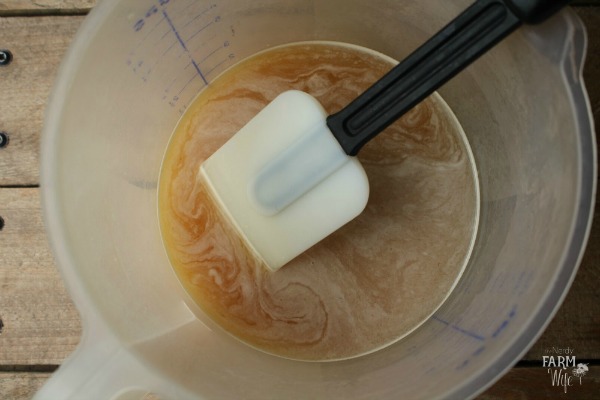
Make the Lye Solution
Wearing gloves, goggles and long sleeves, weigh the water into a stainless steel or heavy duty plastic pitcher. I use an old Tupperware or Pampered Chef pitcher. Next, weigh the lye into a small cup or container.
Sprinkle the lye into the water (not the other way around or you might get a lye volcano) and gently stir with a heavy duty plastic or silicone spatula or spoon until the lye is completely dissolved. The temperature will get really hot & the tea may turn a strange color, but that’s perfectly normal for herbal teas.
Work near an open window, outside or under an exhaust fan. Avoid breathing in the resulting strong fumes that linger for a few moments. (If you have sensitive lungs, breathing problems, or are concerned about the fumes, consider wearing a mask such as THIS ONE.)
Set the lye solution aside in a safe place where it won’t get disturbed. If you’re making hot process soap in your crock pot, then it will only need to be set aside for about ten minutes while you work with the oils. If making cold process, let the lye cool down around 30 to 40 minutes before mixing with the oils.
Weigh and Heat the Oils & Butters
Weigh out the solid ingredients – coconut oil and shea butter – and melt them in a double boiler or over low heat until melted.
While those melt, weigh out the other liquid oils and place them in your crock pot (for hot process) or soap making pot/container (for cold process).
Pour the hot melted butter and coconut oil into the other oils. That should bring the temperature up to somewhere around 90 to 100°F (32 to 38° C).
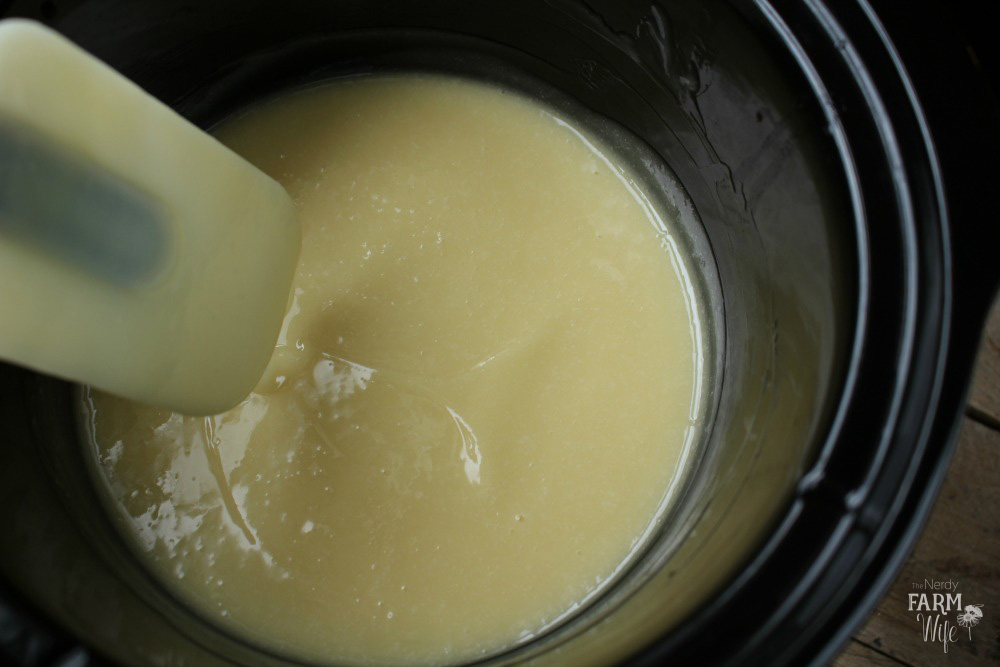
Combine and Mix Until Trace
Pour the lye solution into the warm oils. Using a stick or immersion blender (looks like THIS and is not a handheld mixer) stir the solution with the motor off for around 30 seconds.
Turn the motor on and blend for a minute or so. Stir for another 30 or so seconds with the motor off, then again with the motor on and so forth.
Don’t run the stick blender continuously so you don’t risk burning out the motor and/or causing excessive air bubbles in your finished soap.
Alternate with this method until trace is reached. “Trace” is when your soap batter gets thick enough to leave an imprint or tracing, when you drizzle some of it across the surface. Above is a picture of my soap at trace.
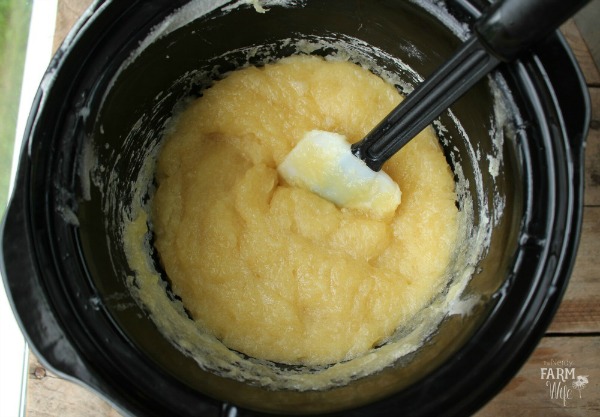
Choose Cold Process or Hot Process
Up until this point, you make cold process and hot process pretty much the same. Weigh, melt/heat and stir to trace. Now though, you have to decide if you’re going to cook your soap (hot process) or pour it straight into a mold (cold process).
With cold process, you just stir to trace, add essential oil and any other extras, pour the soap batter into the mold, let it sit for 24 to 48 hours, remove from the mold and cure the bars in the open air for 4 to 6 weeks before using. It’s one step shorter than hot process and your bars will usually end up looking nicer and smoother. However, there’s that 4 to 6 week wait time for the bar to cure.
With hot process, you stir to trace, cook your soap for around an hour, add essential oil and any other extras, then scoop it into a mold, let it sit for 24 hours, remove it from the mold and you can use it right away. However, hot process still does best and will last longer if you let it cure at least a few weeks.
The choice is completely personal. No one way is better than the other, so choose as you wish!
Cold Process Instructions
Once trace is reached, you can stir in any extras. In this case, it’s just honey diluted with an equal portion of water. Stir that into the soap batter and pour the soap into a prepared mold.
Because this soap has honey in it – the natural sugars will heat things up more than soap without – you probably won’t need to insulate the mold. Just cover it lightly with a sheet of wax paper and let it sit for 24 to 48 hours. Peek at your soap a few times during the first several hours to make sure it’s not overheating. If you see a crack developing, move it to a cooler area.
Once the soap has firmed up in the mold for a few days, remove and slice into bars. Let the bars cure on sheets of wax paper or coated cooling racks for around 4 weeks before using.
Hot Process Instructions
Once trace is reached, turn your crock pot on low. (If you have a really old crock pot that heats slowly, you might need to preheat it sooner.)
Cook the soap batter for 1 hour, checking every 15 minutes and stirring if needed. (Sometimes, I faithfully stir every 15 minutes. Sometimes, I completely forget to. It all works out in the end though!)
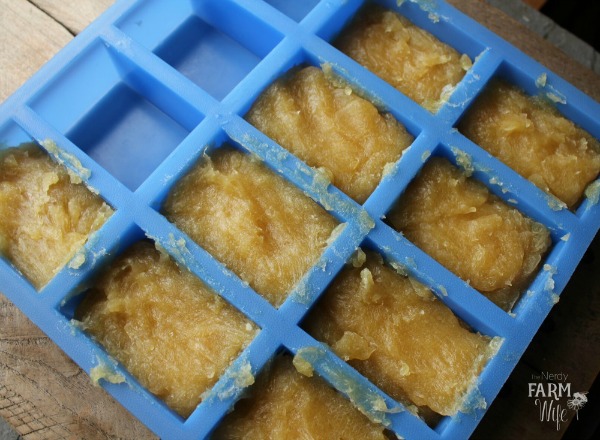
After the soap has finished cooking, let it cool for a couple of minutes before stirring in the honey/water mixture.
If you add the honey while the soap is too hot, it could turn brown and start to smell and look scorched.
Spoon the hot soap into your molds and smooth the tops as best as you can.
I bought the mold shown in the photo above HERE from Bramble Berry. This recipe fills 9 of the 12 cavities.
You don’t have to cover or insulate hot process soap. Let the soap sit in the molds overnight then remove the next day. I usually cut shampoo bars in half again, to make “shampoo sticks”.
You can use this soap right away, though the bars benefit from curing a few weeks too.
And that’s it – you’re done!
Using Shampoo Bars
When using a shampoo bar, it’s best to followup with a vinegar hair rinse to help restore pH and remove any soap residue. This is especially important if you have hard water.
Any type will do, but here are a few pretty infused vinegars you might want to consider for your hair:
Rose Petal Vinegar | Lavender Vinegar | Violet Vinegar

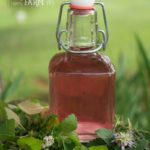

I usually dilute the vinegar with equal parts water to make a rinse or, for more convenience and less waste, keep a spray bottle of vinegar in the shower and spritz it over scalp and hair after shampooing. Follow with a rinse of plain water.
Shampoo Bar Notes
Not everyone’s hair type does well with shampoo bars, so if you find that you don’t care for how they work on your hair, you can still use them as a hand and body soap.
If you’d like a truly natural alternative to commercial shampoos and conditioners, I highly recommend Morrocco Method haircare products.
They’re color safe, paleo friendly, vegan, and gluten free – made in small batches with 100% pure ingredients like apple cider vinegar, aloe, essential oils and other healthy plant extracts.
I’ve especially fallen in love with their Apple Cider Vinegar Shampoo and Floating Lotus Conditioner – they leave my hair so clean and soft, even with our hard well water!
You can learn more about their products HERE.

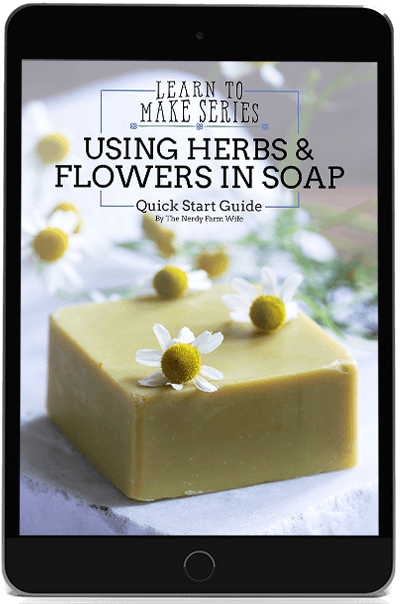

Beautiful! I’ve made soap for 22 years so I appreciate a wonderful bar of handmade soap like no one else I know. Well, besides those like yourself, that is.
I ordered your book, and it’s on the UPS truck out for delivery.
I. can’t. wait. to. get. my. hands. on. it.
Thank you Toni! I appreciate you ordering a copy of my book too! I hope you enjoy it! :)
How many tea bags would you recommend using if you’re going to use bags instead of fresh or dried flowers?
Thanks!
Hi Jen! I’m not sure of an exact number, but you could stack the tea bags in a 1/2 cup measuring cup and get a rough idea of how many to use. It doesn’t have to be precise, just a nice chamomile tea. :)
these look lovely. jan, can any of your shampoo bars be used for color-treated hair? i was planning to make a coconut oil shampoo bar (only 1 oil but superfatted) when i finally try soapmaking, to make it super easy to start, but just read that it isn’t good for color-treated hair.
as for the vinegar rinses i didn’t realize you could use so much vinegar. from what i read on a science website i believe a 50-50 of vinegar & water doesn’t need to be refrigerated as it is self-preserving so i’m going to try that or your spritz technique. :) i’d love to be able to stop buying shampoo & conditioner.
Hi Linda! I’ve heard both ways – that shampoo bars are safe for color-treated, but have also heard that they’re not. I’m not really sure who to believe! (I have learned from reliable sources that liquid castile soap like Dr Bronner’s will strip hair color though.) The one thing about coconut oil in soap is that it’s super cleansing, so my thoughts on that are that maybe you want to use a shampoo bar recipe lower in coconut oil so it won’t strip your hair. I wish I had a better answer for you, but I’m just not sure of the best way to go. Good luck with your soapmaking adventures! :)
thanks jan! i always appreciate all you know on diy recipes. i’ll stay away from too much coconut oil then. i was looking at the chagrin valley website and might try one of theirs before i start soapmaking. they even have one called a conditioner bar and i happened to stumble on some recipes for hair conditioner bars (more like lotion bars as no lye) but they weren’t too natural. one lady who makes them naturally, but didn’t give a recipe, said she uses infusions. i thought of you. :)
i’ve started using the ACV neat in a spritz bottle and that works perfectly. my hair is loving it so far and so easy & inexpensive. it’s really amazing how all these natural & inexpensive recipes work so well and are so healthy.
The Chagrin Valley soaps look fantastic, so great idea to try them out! So happy that the ACV is working for you in the spritz bottle. I love how convenient it is! :)
hi again jan. i am gathering supplies to start soapmaking (yea!) and while it may be a little bit before i try a shampoo bar i have been reading up on them. i wondered what you use for a superfat for your shampoo bars. i tried to figure it out from your recipes but i don’t quite know how to calculate it. thanks! i always appreciate your knowledge & patience in answering all my questions.
Hi Linda! Hooray for getting ready to start soapmaking! :) I usually calculate the superfat right into the recipe & most often use 6%, but sometimes use 5%. For shampoo bars, some people like to go with a lower superfat (4% or 5%) which makes them more cleansing (but, also possibly too drying for dry hair types). On the flip side, some like to have a higher superfat of around 8% so the bar is more moisturizing, but you risk weighing your hair down if it tends to be oily or you have hard water. What superfat you end up liking best will really depend on your hair and water type & sometimes takes a bit of experimenting.
thanks for such a great explanation. i was having trouble finding info on what is a good SF for shampoo bars and this makes a lot of sense.
jan, i don’t know if you’ve ever thought about teaching classes but i think you’d be great at it. i have learned so much from you.
Thanks for the kind words Linda! I’ve thought about teaching classes locally & like the idea! Maybe one day I’ll have the setup to do so! :)
I have been waiting to pick my own chamomile and they are finally in full bloom! Can’t wait to try this recipe and see how turns out!
Hi Vicky! I hope you enjoy it! :)
Dear Jan: I recently made your wonderful shampoo bars and just want to say thank you for sharing the recipe. It is so much fun to make them first of all, and I love how it leaves my hair. I am happy to know what isn’t in my shampoo! :| It is also fun to have a unique item to give as a hostess gift, thank you gift. You have a wealth of wisdom and I so appreciate your sharing it with us.
Barb
Hi Barb! I’m so glad that you like the recipe! It’s one of my favorites too. :)
I really love all of your recipes! They really work up great. I made this one today. Had to remake my tea as I think I left my original ice cubes in the trays too long in the freezer and there wasn’t much left to them. So more tea, more ice cubes and it worked up beautifully. I was really surprised how yellow my soap worked up. I did double my recipe via soapcalc.net. I also added some tumeric to about half of the batch so I could do some swirls. Can’t wait until I can cut it! Added some chamomile buds on top. Thanks again for all your hard work in creating these recipes!
Hi Vicky, I’m so glad that you enjoy the recipes! It sounds like your soap turned out beautifully; I love the idea of making swirls in it with turmeric! :)
Hi!! Thank you for sharing this amazing recipe! I just made a triple batch for Mother’s Day in the law firm I work for. While I was pouring the paste into the molds and even when I was washing the utensils, my hands were itchy and I got a little worried. I washed my hands and it went away. Will this “itchy factor” go away after the soap is cured?
Hi Mariana! The soap shouldn’t make your hands itchy, though it’s a possibility if the lye wasn’t neutralized completely during cooking. If that’s the case, then it will finish reacting with all of the oils while the soap cures. (Usually the lye is virtually all “used up” within 24 to 48 hours after making soap, no matter which method you use.) If you test a bar and it still makes your hands itchy after 3 weeks, then you may have a sensitivity to one of the ingredients (occasionally people with ragweed allergies can react to chamomile too). If the soap makes other people’s hands itchy though, then somewhere along the way the lye or an oil may have gotten mismeasured. If you have pH strips you could use those to test your soap. To do that, rub some distilled water over a bar of soap (while wearing gloves) to make a thin soapy mixture. Rub that over a pH test strip. The soap should have a pH of around 9 or 10. Anything over 10 needs more cure time or may have too much lye in it.
I love the sound of this shampoo bar but unfortunately (like many shampoo bar recipes) it has coconut oil in it. Any recommendations for an oil replacement for someone who’s allergic to nuts/seeds? thanks!
Hi Cheyenne! I normally recommend babassu oil as a substitute for coconut oil in soap recipes. However, babassu is pressed from the seed of the babassu palm, so that leaves it out as well.
It’s going to be tough to replace the high cleansing & lathering that coconut gives to a shampoo bar, but if you’re able to use castor oil, definitely keep that in the recipe.
Are you able to use tallow or lard? What other oils and ingredients can you use? If you reply back with a list, we’ll see if we can figure out a recipe you can use. :)
Hi Jan! Can I replace the sweet almond oil with jojoba oil? I love how you broke down the process for both cold and hot process bars!
Hi Erica! Yes, you can, though you’ll need to adjust your lye amount since jojoba has much different requirements for lye than many other oils.
The lye amount will change to 3.8 oz (108 g).
This is a snapshot of the updated recipe ran through a lye calculator for reference. :)
https://thenerdyfarmwife.com/wp-content/uploads/2017/06/chamomile-tea-bar-with-jojoba.jpg
Thanks, I forgot about that. I like that calculator and the ranges that it gives you. Would you recommend the substitution of jojoba for sweet almond though? when I run it through the soapcalc lye calculator, it doesn’t seem like it would change the properties of the soap that much, but I’d love to hear your thoughts
Hi Erica! Yes, I think that’s a wonderful substitute! Jojoba oil is great for hair care products. :)
I made the shampoo bars today! I opted for the hot process. My soap batter came to trace really quickly – like after one round of mixing with the immersion blender off for a minute and then on for minute. I mixed it a little more because I was kind of incredulous that it happened so quickly, and then I turned the crockpot on low. I forgot to check it after 15min, but after 30min, it seemed more solid than your picture looks after 1 hour! Any idea what happened that it came to trace and solidified in the crockpot so quickly? I weighed everything carefully and adjusted the lye to 3.8oz like you said due to the jojoba oil substitution. Most of my oils were really new and I think fresh, except for the castor oil. I used a small crockpot – could it just be the lower surface area to volume ratio?
I spoke too soon! I should have trusted the process ;) When I came back at the 1 hour mark, it looked like your picture. I mixed in the honey and put it in molds and it seems to have turned out great! When I used it, I got a great lather and my hair came out really clean and silky. I’m so excited for a sulfate- and palm oil-free shampoo solution that I can trust, customize, and that works well! Thanks again, Jan!
Yay! So glad that it turned out well! :)